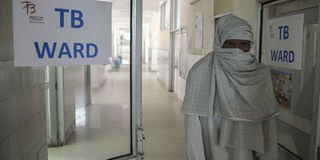TB deaths in HIV patients increase for first time in 10 years

A patient who has been diagnosed with tuberculosis (TB) looks out from a TB ward at a government hospital in Jalandhar, India. TB remains the leading cause of death among people living with HIV globally.
What you need to know:
- TB deaths increased for the first time since 2010, an upward trend expected to worsen in 2022
Tuberculosis deaths among people living with HIV has increased for the first time in 10 years with 214,000 such deaths recorded in 2020, a global TB lobby group has said.
As the world marks AIDS Day today December 1, Stop TB Partnership has warned the deaths are likely to increase further in light of underfunding of TB services.
TB remains the leading cause of death among people living with HIV globally.
Stop TB Partnership Executive Director Dr Lucica Ditiu said the deaths have increased for the first time since 2010 after recording decline in the last decade.
Dr Ditiu explained the decline was reversed due to the Covid-19 pandemic which reduced access to TB diagnosis and treatment services.
She pointed out that around the world, eight percent of people with TB are also living with HIV, with the proportion highest in the Africa where it exceeds 50 percent in parts of Southern Africa.
Due to a dramatic lack of resources, said the executive director, especially in the African region, millions of lives have been lost.
“Every day, close to 600 people living with HIV die from TB yet most of these deaths could have been averted,” said Dr Ditiu.
“It is so upsetting to see that HIV prevention and treatment extends people’s lives, only to see one in three of them dying because of TB.”
According to the latest World Health Organisation (WHO) Global TB Report, in 2020, TB deaths increased for the first time in over a decade, going up to as high as 1.5 million, an upward trend that is expected to worsen in 2021.
TB deaths among people living with HIV represented around 14 percent of all the deaths from TB last year.
At the moment, said Dr Ditiu, people living with HIV face a triple burden of disease, threatened not only by HIV itself but also by Covid-19 and TB.
“We might not be able to prevent all co-infections, but we definitely know how to prevent, and treat TB. Still, TB funding remains pathetically low compared to other disease areas, and insufficient even for diagnosis and treatment,” she added.
Globally, about half of people living with HIV who develop TB are being diagnosed with and treated for TB, leaving behind the remaining half to face the consequences of untreated TB and the associated high fatality levels.
“Further investments, modern TB diagnostics, regular screening for TB (such as X-ray and rapid molecular tests) are needed to alter this trend,” she said.
The United Nations-hosted entity based in Geneva, Switzerland, is committed to revolutionising the tuberculosis (TB) space to reduce the toll of the disease worldwide and ultimately achieve a world-free of TB by 2030.
Already, UN’s target of reaching six million people living with HIV and TB preventive treatment by 2022 has been achieved ahead of time.





